Convergence in the DOOH market
by Matthew | 21 January 2012 11:51 am
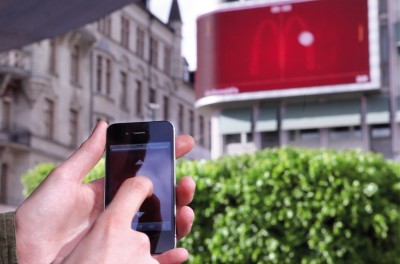 [1]
[1]Photo courtesy DDB
By Michael Mascioni
For some time, digital out-of-home (DOOH) was considered a discrete, narrow niche business, far removed from other forms of advertising. That assumption is now changing dramatically, with DOOH increasingly becoming part of cross-media marketing campaigns.
The shift has been driven largely by changes in technology, content distribution, consumer lifestyles and advertising strategies. Online and mobile communications, for example, and the ability to combine physical and virtual experiences have opened new possibilities for DOOH to reach a larger audience, enhance brand awareness and cross-promote products. A greater emphasis on ‘experiential’ marketing favours the kinds of multimedia approaches that can integrate DOOH.
“Convergence is the future of digital signage,” says Rob Gorrie, president of Adcentricity, which operates a broad DOOH network from its offices in Toronto, Chicago, Ill., and New York, N.Y. “It extends marketing opportunities for advertisers and builds closer relationships with consumers.”
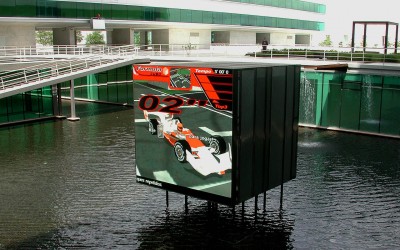 [2]
[2]Back in 2002, the Vodafone Cube in Lisbon, Portugal, allowed visitors and employees to interact with multiplayer games, videos and other content displayed on a large screen. Photos courtesy YDreams
Indeed, multi-channel marketing campaigns incorporating DOOH fit in well with overall marketing trends toward more user-centric brand experiences, which often involve a greater element of play through games and other initiatives.
“Combining mobile, online and OOH elements is the only way to present a truly interactive marketing campaign in public places,” says Steve King, VP of sales for LocaModa, which develops social media applications for digital signage platforms.
The ultimate remote control
Digital signage can allow passersby to interact with large-screen games and other content, for example, by letting them use their smart phone or other mobile device as a ‘remote control.’ Exploiting the ubiquity of mobile phones—and, for that matter, web connections to digital signage, which were not typical in the early days of the medium—a popular context is created for interactive marketing in public spaces.
“Mobile interactivity dramatically shifts the digital signage paradigm from one-to-many to one-to-one communications,” says H. Jay Patel, president of BlueFire Digital, a Silicon Valley provider of mobile marketing platforms. “Mobile is comfortable for users, as it does not force them to interact at arm’s length, like a kiosk does. It eschews the need to learn how to use a new device.”
The advantages of this approach include targeting audiences better, providing more measurable advertising impact, linking various interactive media, tapping into social networks and deepening the consumer’s association with a brand and promoting greater public acceptance of mobile marketing.
“It is a powerful tool, bringing consumers closer to brands,” says Patel.
Digital signage already adds interactive marketing dynamics to many public places, but by being teamed with mobile devices, the scope of that marketing can be expanded further, offering more spontaneous and direct communications. Not only can branding efforts be enhanced, but from the consumer’s perspective, there are opportunities for user-generated content to be delivered to digital signage.
“Mobile-driven digital signage affords a higher level of interactivity that didn’t exist before,” says Jeremy Lockhorn, vice-president (VP) of the emerging media practice (EMP) at Razorfish, a marketing and advertising agency with offices across North America and Europe, as well as in Brazil, Australia, China and Japan. “Mobile devices are becoming the ultimate remote control. They have the capability to build bridges to other media.”
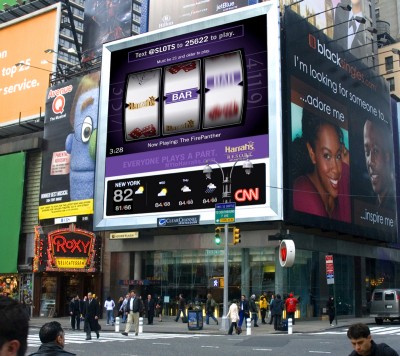 [3]
[3] [4] Working in partnership with Clear Channel Spectacolor, LocaModa has launched games like Jumbli (bottom) and a Harrah’s slot machine (top) on a digital screen at New York’s Times Square. Passersby played these games by using their mobile phones. Photos courtesy LocaModa
[4] Working in partnership with Clear Channel Spectacolor, LocaModa has launched games like Jumbli (bottom) and a Harrah’s slot machine (top) on a digital screen at New York’s Times Square. Passersby played these games by using their mobile phones. Photos courtesy LocaModa
Lockhorn advises taking care, however, when exploiting these new media options.
“You need a clear and well-defined strategy,” he says, “and not all brands or products lend themselves to mobile campaigns.”
It is also important to offer something to the busy consumer.
“To succeed, mobile signage campaigns must offer either clear entertainment or monetary value,” says Dan Trigub, chief development officer for Blue Bite, which delivers digital content to phones within select zones. “There should be unique content designed for mobile users, such as digital coupons or behind-the-scenes movie trailers.”
One relatively new trend in mobile-driven digital signage is offering downloads of mobile apps. A DOOH campaign developed by Blue Bite and RMG Networks, for example, promoted an app for business travellers using screens in airports. This way, the app was showcased in a contextually relevant environment.
Increasing accountability
One of the reasons advertiser interest has grown is accountability, as interactivity allows customer feedback. Measuring systems are particularly well-established for Short Message Service (SMS), proximity-based downloads and the scanning of bar codes and Quick Response (QR) codes.
“There is greater accountability than was previously possible in public spaces,” says Lockhorn. “The applications are more valuable from a return on investment (ROI) perspective, as they have been shown to increase brand awareness significantly.”
“The more highly interactive the campaign, the greater the data,” says Trigub. “While traditional brand impression measurements have value, they do not offer the level of accountability providing by actual user actions, such as downloads prompted by a call to action.”
One of the earliest examples of successful interactive mobile marketing in public places was the Vodafone Cube, a 4 x 4-m (1.2 x 1.2-ft) structure that debuted in Lisbon, Portugal, back in 2002. Developed by YDreams, a local interactive technology company, it targeted both visitors and employees at Vodafone’s Lisbon headquarters, allowing them to interact with multiplayer games, product demonstrations, videos and other content displayed on a large screen.
To accomplish this interactivity, users had to call a number shown on the screen, which routed them through a digital audio switchboard to a computer server. Once connected, they joined a real-time game with up to four participants in total. According to YDreams, hundreds of people interacted with the Cube’s content each day.
In 2008, BlueFire gathered user response feedback to a mobile-driven digital signage project it conducted with Sha Keb Consultancy on two weeknights at an upscale bar in Sacramento, Calif. The project involved a bar employee taking photos of patrons with his cell phone and sending them via Multimedia Messaging Service (MMS) to screens, where they were displayed along with text messages sent by viewers.
Starting at 10 p.m. on each of the nights, the content was run continuously for four hours. The project involved three displays, one of which was projected behind the bar.
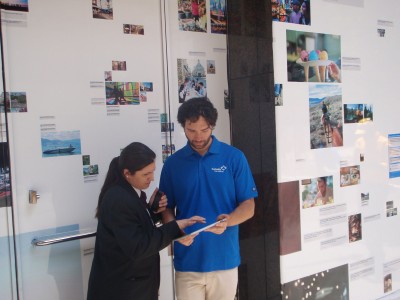 [5]
[5]In 2010, a campaign promoting Canadian tourism made heavy use of Twitter and YouTube to bring photos, videos and other user-generated content to storefront digital signage. Photos courtesy DDB Canada
Feedback showed the most common interactions with the screens were a minute or less, but 16 viewers interacted with them for much longer, between 30 minutes and two hours. And the majority of viewers interacted more than once, including nine patrons who each sent multiple texts to the screens within a 15-minute period. The heaviest period of interaction was around 11 p.m.
That same year, MegaPhone Labs developed an interactive mobile campaign for Adidas at the National Basketball Association (NBA) All-Star Game in New Orleans, La. The ‘guerrilla’ campaign used a branded van, outfitted with a 3-m (10-ft) screen and parked at a street corner near the game.
“It essentially combined OOH, casual games, mobile marketing and location-based services,” says Dan Albritton, co-founder and CEO of MegaPhone. “It was designed to encourage engagement with the brand through interactivity and add names to the Adidas mailing list. Participants received location-based SMS notifications of special events and promotions at their nearest Adidas stores.”
The interactive campaign generated three times as many opt-ins as all other promotional methods combined, including radio, TV, billboards and print.
“And they opted out only half as much compared to all other paths,” says Albritton. “Ultimately, the campaign was vastly superior in terms of cost and response rate.”
Game on!
As mentioned, games have proven a particularly effective way to raise brand awareness. In the past, for example, LocaModa has also partnered with Clear Channel Spectacolor, which operates a 12.2 x 12.2-m (40 x 40-ft) digital screen in Times Square in New York, N.Y., to launch a series of interactive games for passersby.
Their first joint application was Jumbli, a word game based on text messaging and also playable from a dedicated website. Standing in Times Square, players submitting the highest-scoring words from their mobile phones could then see their names appear on the screen, along with online players’ winning entries. The game ran four to five times each day, with ads appearing on a lower portion of the screen.
LocaModa also developed an interactive game for the same billboard on behalf of Harrah’s Entertainment. In this case, the application took the form of a mobile-controlled virtual slot machine.
“Very simple games with clear instructions and a user-friendly interface tend to perform best in public places,” says Jayne Karolow, LocaModa’s director of community. “Users in the OOH environment must be able to enter a game at any time and immediately understand how it works or they’ll simply move on.”
Social networking
Other DOOH campaigns have achieved success by tying in with social media for marketing purposes.
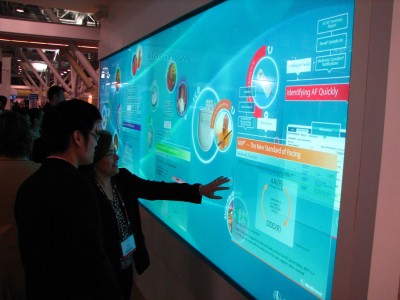 [6]
[6]GestureTek, based in Toronto, adds gesture-based interactivity to a range of dynamic displays. Photo courtesy GestureTek
“This fusion of OOH and online social networks is powerful in helping extend the reach of brands and advertisers,” says LocaModa’s King, “while offering consumers the benefit of connecting seamlessly with their peers, whether they are at the same venue or in distant locations.”
Extending the reach of an initial OOH campaign to the web through social networking features, King claims, can deliver more overall impressions than an OOH project could on a stand-alone basis. Several years ago, his company calculated a generic text message campaign via a digital signage network comprising 1,000 bars, for example, would generate 60,750 messages from consumers per month, whereas a localized campaign connected to a social network would yield 431,000 messages per month.
LocaModa’s past efforts to bring social networking to digital signage have allowed consumers to interact, via their mobile phones, with content on large screens in coffee shops and other locations, then transfer those interactive experiences to Facebook and other social networking sites. Thus, a customer in a social setting like a bar could interact not only with fellow patrons in the same venue, but also with friends elsewhere online.
Customers can also to choose to respond, via text messages, to an interactive ‘call to action’ within a digital sign ad, then see their responses instantly posted on that venue’s social network pages and news feeds. LocaModa and OOH ad agency Posterscope have found these and other social media applications are an ideal way to run an advocacy campaign or offer consumer rewards and are beneficial in creating greater audience engagement.
In 2010, the Italian clothing company Diesel ran a two-week ‘Be Stupid’ multi-platform campaign in Denmark, developed by Comtech Experience using Never.no software. Centred on the theme of “the relentless pursuit of a regret-free life,” the branding project invited the public to submit photos of themselves and their friends in amusing and playful poses, which were then displayed on Facebook, digital signs in Diesel stores and projected wall surfaces in Copenhagen simultaneously.
The advertiser was prepared to let anything happen, with the campaign using only real-time content moderation.
“One of the goals was getting customers more involved with the brand,” says Karsten Solaas, managing director of Comtech. “Another key goal was building a longer-term relationship by attracting members to their Facebook group. The campaign succeeded in generating a great deal of activity through that group.”
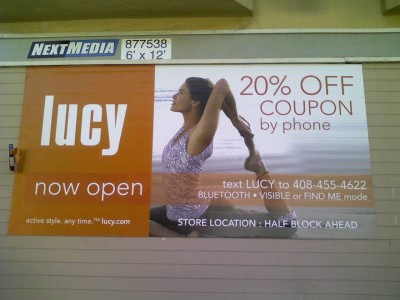 [7]
[7]BlueFire Digital has provided mobile marketing platforms for out-of-home (OOH) advertising, including traditional static billboards. Photo courtesy BlueFire Digital
Also in 2010, the Canadian Tourism Commission (CTC) launched a promotional campaign in the U.S. that used social media and user-generated content to create Twitter-based ‘storescape murals,’ featuring a stream of photos, videos and conversations relating to Canadian cities, cultural experiences and vacations. Developed by ad agency DDB Canada, the campaign encouraged Canadians and Americans alike to interact with the digital billboards, including passersby who could use them as touch screens.
In this case, digital signage was an outgrowth of CTC’s extensive social media efforts, as well as part of a broader campaign that included TV and radio ads. The idea was to highlight unique, compelling qualities of Canada to American travellers.
Response was positive, with 97 per cent of participants becoming followers of CTC’s Twitter feed, 20,000 people actively tweeting during the campaign, 5,000 photos posted, 40,000 views of CTC’s YouTube vacation travel programming and a total of five million impressions.
Stumbling blocks
Nevertheless, the medium still faces some challenges. Lockhorn cautions against “overloading consumers with more ad clutter.”
King at LocaModa agrees.
“Consumers have been bombarded for so long by passive media, they tend to block out advertising altogether,” he says. “The key challenge is conveying to the customer that this kind of experience is in fact interactive.”
Another stumbling block in the past has been a paucity of technology to properly integrate mobile devices with digital signage. Specialized companies have developed a wide array of products to fill the gap.
“Mobile-driven digital signage marketing campaigns are currently limited in their reach, requiring the marketer to balance scale versus impact,” says Lockhorn, “but as technology standards continue to emerge, the scale will come. Marketers who experiment today will be in a stronger position once that scale is achieved.”
He also points out the effectiveness of an interactive technology in a public setting will depend on the environment where it is applied. An application that works well in an airport, for example, may not be suitable for a coffee shop.
“Also, it’s not clear these techniques are well-accepted by a majority of advertisers,” says Steven L. Gurley, senior vice-president (SVP) of global marketing and business development for Symon Communications, which develops software for digital signage, information kiosks and other media. “Some are resistant to these techniques because they often focus on small audiences. And a significant number of advertisers are confused and threatened by the new mobile landscape.”
According to Donna Boyer, a manager for Reach Media Networks, advertisers and marketers should into account the strengths and weaknesses of different forms of interactivity.
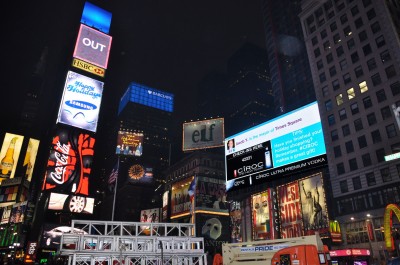 [8]
[8]Recently, LocaModa has used social networking to drive user-generated content onto a large outdoor screen.
“It is important to format material correctly, to ensure it works properly on mobile phones,” she says. “The content strategy should be well-calibrated beforehand.”
Future momentum
Despite any remaining limitations, momentum is continuing to build for mobile-driven digital signage. And its emergence has been in tandem with the growing implementation of gesture-based interactive systems in public spaces.
“There will be greater convergence between mobile and gestural systems, opening up even more expansive forms of interactivity in those settings,” says Vincent John Vincent, president of Toronto-based GestureTek, which uses ‘applied computer vision’ camera-based technology in multimedia displays, exhibits, digital signs, kiosks and gaming systems.
In such ways, the digital signage sector continues to transform interactive marketing into a more powerful, engaging and intuitive experience, while also expanding in scope as an element of cross-channel marketing.
Michael Mascioni is an independent market research consultant and the project manager for the Digital Out-of-Home Interactive Entertainment Association (DNA) Conference, scheduled for April 26, 2012, in Los Angeles, Calif. With files from Digital Signage Today and Warc. For more information, contact him via e-mail at mmmascioni@aol.com[9]. and visit www.digitalsignagetoday.com[10], www.warc.com[11] and www.thestingerreport.com/us-conference.html[12].
- [Image]: http://www.signmedia.ca/wp-content/uploads/2014/02/ddbmcd.jpg
- [Image]: http://www.signmedia.ca/wp-content/uploads/2014/02/vodafonecube2.jpg
- [Image]: http://www.signmedia.ca/wp-content/uploads/2014/02/locamodaharrahs.jpg
- [Image]: http://www.signmedia.ca/wp-content/uploads/2014/02/locamodajumbli.jpg
- [Image]: http://www.signmedia.ca/wp-content/uploads/2014/02/DDBandCTC4.jpg
- [Image]: http://www.signmedia.ca/wp-content/uploads/2014/02/gesturetek1.jpg
- [Image]: http://www.signmedia.ca/wp-content/uploads/2014/02/bluefirebillboardnotdigital.jpg
- [Image]: http://www.signmedia.ca/wp-content/uploads/2014/02/locamodafoursquaretimessquare.jpg
- mmmascioni@aol.com: mailto:%20mmmascioni@aol.com
- www.digitalsignagetoday.com: http://www.digitalsignagetoday.com
- www.warc.com: http://www.warc.com
- www.thestingerreport.com/us-conference.html: http://www.thestingerreport.com/us-conference.html
Source URL: https://www.signmedia.ca/convergence-in-the-dooh-market/